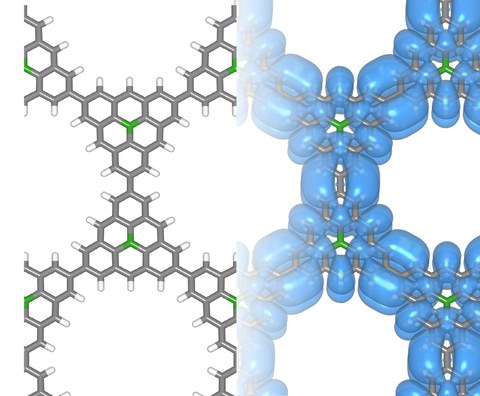Oct 15, 2024
Magnetism without metal: a milestone for materials science
Dr Hongde Yu and Prof Thomas Heine from TUD Dresden University of Technology have succeeded for the first time in predicting metal-free organic magnetic materials using precise computer simulations. These magnetic two-dimensional (2D) polymers could play an important role in data storage, medical technology or quantum computing in the future. Their discovery was recently published in the renowned journal “Science Advances”.
Magnetism has fascinated people for centuries: whether children playing with magnets or scientists researching the fundamental forces behind the phenomenon. It is widely known that magnetism in nature is usually closely associated with metals - classic permanent magnets, for example, are based on iron or other metals.
Now Hongde Yu and Thomas Heine from the Chair of Theoretical Chemistry at Dresden University of Technology have shown for the first time through calculations that it is also possible to generate magnetism in purely organic materials. The scientists used so-called triangulenes, triangular molecules that have unpaired electrons and therefore a magnetic moment, as the basic building block. When these molecular building blocks are combined to form a 2D solid, these unpaired electron spins arrange themselves to create a ferromagnetic material.
“This is fundamentally new,” explains Hongde Yu. “Normally, the electron spins in organic materials have a random orientation and therefore cancel each other out in the solid. Through suitable chemical bonds, the spins arrange themselves in the 2D crystal, creating a ferromagnetic material.”
“Magnetism is based on the robust coupling of electron spins between neighboring molecular building blocks. In contrast to magnetism in metals, where the electron spins are localized at the metal atoms, we see a delocalized spin density that is distributed over the entire triangulene molecular compound. Depending on the composition of the molecule, so-called “Stoner ferromagnets”, where the spins of neighboring molecules are parallel, or antiferromagnetic Mott insulators, where the spins of neighboring molecules are opposite, can form,” explains Heine. The discovery that magnetic moments can be orderly coupled in metal-free materials opens the door for the development of magnetic materials where metals are undesirable, e.g. due to their weight or toxicity. Metal-free magnets could prove to be more robust and biocompatible, which would be particularly important in medical technology.
With this groundbreaking work, the research team has discovered a new class of magnetic materials that is not only theoretically fascinating, but also has the potential to significantly influence future technological developments.
The research work was largely funded by the German Research Foundation's Collaborative Research Center (CRC) 1415 “Chemistry of Synthetic Two-Dimensional Materials”, which was launched in 2020. As a guest scientist at the Center for Advanced Systems Understanding CASUS in Görlitz (an institute of the Helmholtz-Zentrum Dresden-Rossendorf HZDR), Heine is involved in the recently successfully extended CRC.
Original publication:
Yu, Hongde und Heine, Thomas. Prediction of metal-free Stoner and Mott-Hubbard magnetism in triangulene-based two-dimensional polymers. Science Advances. Vol 10, Issue 40. DOI: 10.1126/sciadv.adq7954
Contact for journalists:
Prof Dr Thomas Heine
Dresden University of Technology
Chair of Theoretical Chemistry
Phone: +49 351 463-37637
E-mail:

